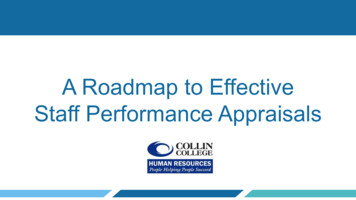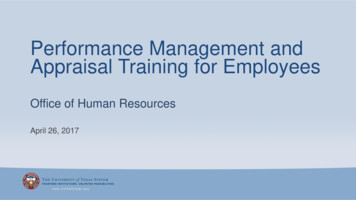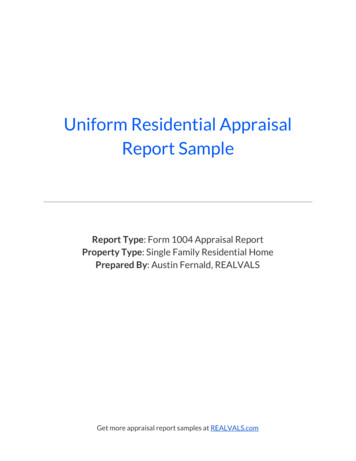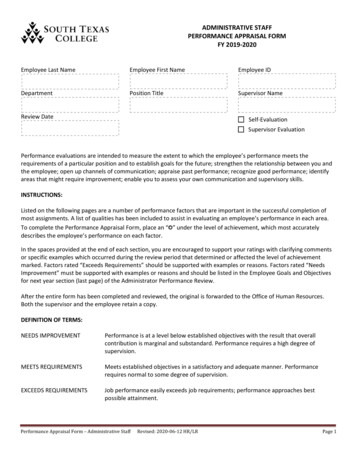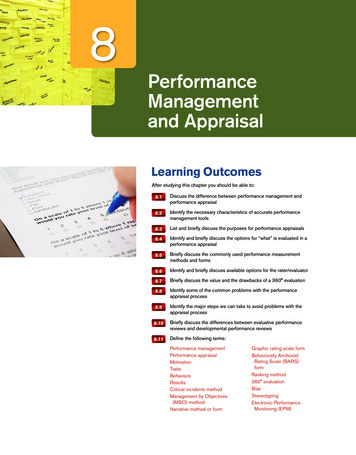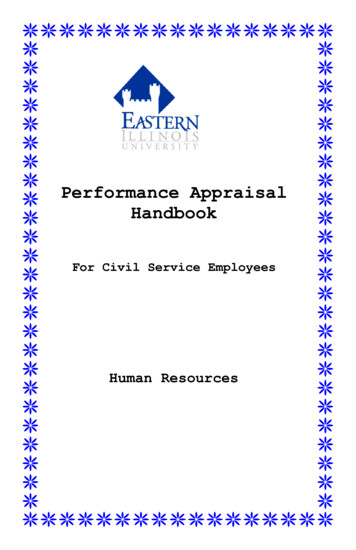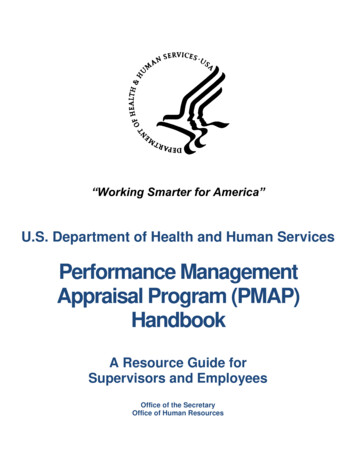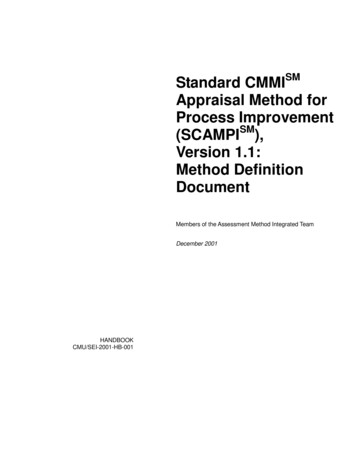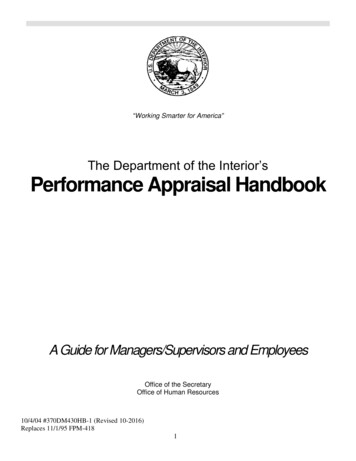
Transcription
“Working Smarter for America”The Department of the Interior’sPerformance Appraisal HandbookA Guide for Managers/Supervisors and EmployeesOffice of the SecretaryOffice of Human Resources10/4/04 #370DM430HB-1 (Revised 10-2016)Replaces 11/1/95 FPM-4181
Table of ContentsTimeline for the Performance Appraisal Process . 3Introduction . 4Section 1- PLANNING . 5Developing Employee Performance Appraisal Plans (EPAP) . 5Elements. 5Standards (Benchmark Performance Standards) . 6Employee Participation . 10Documenting Elements and Standards . 10Section 2 – MONITORING . 10Feedback during the Performance Year . 10Progress Reviews . 10Section 3 – DEVELOPING EMPLOYEES . 12Formal Development . 12Informal Development . 13Section 4 – RATING . 14Eligibility. 14Interim Appraisals . 14Rating Critical Elements . 14Rating of Record . 15Discussion with Employee . 15Reconsideration Process . 16Section 5 – ACTIONS BASED ON PERFORMANCE . 18Rewarding Performance. 18Links to Other Personnel Actions . 18Dealing with Poor Performance. 19APPENDIX 1 – GPRA Examples for Individual Bureaus/OfficesAPPENDIX 2 – Developing Performance StandardsAPPENDIX 3 – A Supervisor’s Guide on How to get the Most out of PerformanceAppraisalsAPPENDIX 4 – An Employee Guide on How to get the Most out of Performance AppraisalsAPPENDIX 5 – Supervisor’s Guide to Developing Individual Development Plans Sample Individual Development PlanAPPENDIX 6 – Checklists for Dealing with Poor PerformanceAPPENDIX 7 – Frequently Asked QuestionsAPPENDIX 8 – EPAP Forms Employee EPAP -3100 for fy 2017.doc Supervisory Employee EPAP 3100s for fy 2017.doc10/4/04 #370DM430HB-1 (Revised 10-2016)Replaces 11/1/95 FPM-4182
Timeline for the Performance Appraisal System5-Level Performance SystemOr as otherwise approved by the DOI Officeof Human ResourcesOr 30 days after the end of the PerformanceAppraisal PeriodOr 60 calendar days from beginning ofappraisal cycleOctober 1 toSeptember 30October 1 to 31October 1 toNovember 3090 CalendarDaysOr approximately midway throughPerformance Appraisal periodMarch throughMayAs Required10/4/04 #370DM430HB-1 (Revised 10-2016)Replaces 11/1/95 FPM-4183Appraisal Period – The appraisal periodcoincides with the fiscal year, October 1 toSeptember 30.Complete the performance appraisal forprior fiscal year that ended on September30.Deadline to finalize performance standards– Timeframe in which performance standardsare finalized and approved. 60 days is the timea rating official should have issued to employeeelements and standards, i.e., establish anEmployee Performance Appraisal Plan (EPAP).Minimum Appraisal Period – The length oftime, 90 calendar days, that the employee mustbe performing under an approved EPAP in agiven position in order to be eligible for aninterim or annual rating.Progress Review – Discussion with theemployee at least once during the appraisalperiod to review the employee’s progress andcommunicate performance as compared to theestablished standards; to make anyrecommended revisions to criticalelements/performance standards; and toconsider/identify any developmental needs orperformance improvement required.Interim Appraisal – Required when anemployee has worked under standards in theposition for 90 days and if one or more of thefollowing occurs: Employee changes position(i.e., reassignment, promotion, change to lowergrade, transfer), completes a temporaryassignment of 120 days or more (i.e., detail,temporary promotion, etc.), the rating officialleaves a supervisory position, or to document alevel of competence determination for withingrade increase purposes when the employee’smost recent rating of record is not consistentwith the level of competence determination.
INTRODUCTIONThis handbook is designed forDepartment of the Interior rating officialsand employees to assist with themanagement of employee performancethat is aligned with and supportsorganizational goals. It is divided into fiveareas coinciding with OPM’s definition,with the final section expanded to includetaking other actions based onperformance including dealing with poorperformance.Managing employee performance is anintegral part of the work that all managersand rating officials perform throughout theyear. It is as important as managingfinancial resources and program outcomesbecause employee performance or the lackthereof, has a profound effect on both thefinancial and program components of anyorganization.The Department of the Interior’sperformance management policy isdesigned to document the expectations ofindividual and organizationalperformance, provide a meaningfulprocess by which employees can berewarded for noteworthy contributions tothe organization, and provide amechanism to improveindividual/organizational performance asnecessary.To accomplish these objectives,managers need to identify organizationalgoals to be accomplished, communicateindividual and organizational goals toemployees that support the overallstrategic mission and/or GovernmentPerformance and Results Act (GPRA)goals of the Department of the Interior,monitor and evaluate employeeperformance, and use performance as abasis for appropriate personnel actions,including rewarding noteworthyperformance and taking action to improveless than successful performance.The Office of Personnel Managementdefines performance management as thesystematic process of: planning work and setting expectations continually monitoring performance developing the capacity to perform periodically rating performance in a summary fashion; and rewarding good performance10/4/04 #370DM430HB-1 (Revised 10-2016)Replaces 11/1/95 FPM-4184
ELEMENTS The Department’s policy outlinesthat employees may have a minimum of one andnot more than five elements in their appraisalIn an effective organization, work is planned inplans, all of which will be considered critical.advance. This includes setting performanceThrough these elements, employees are heldexpectations and goals for individuals in order toaccountable as individuals for work assignmentschannel efforts toward achieving organizationaland responsibilities ofobjectives. Involvingtheir position. A CriticalPerformance elements tell employees whatemployees in the planningElement is an assignmentthey have to do and standards tell them howprocess is essential to theirwell they have to do it.or responsibility of suchunderstanding of the goalsimportance thatof the organization, what needs to be done, whyUnsatisfactory performance in that element aloneit needs to be done, and expectations forwould result in a determination that theaccomplishing goals.employee’s overall performance isUnsatisfactory. As defined by law, failure on oneDEVELOPING EMPLOYEE PERFORMANCEor more Critical Elements can result in theAPPRAISAL PLANS (EPAP) The regulatoryemployee’s reassignment, removal, or reductionrequirements for planning an employee’sin grade. Consequently, Critical Elements mustperformance include establishing the elementsdescribe work assignments and responsibilitiesand standards in their EPAP. An EPAP outlinesthat are significantly influenced by an employee’sthe specific elements and standards that thework effort and within the employee’s control.employee is expected to accomplish during theFor most employees this means that Criticalrating cycle. Performance elements andElements cannot describe a group’sstandards should be strategically linked, resultsperformance. However, a supervisor or managerfocused, measurable, understandable, verifiable,can and should be held accountable for seeingequitable, achievable, and provide for meaningfulthat results measured at the group or team leveldistinctions between levels of performance. Inare achieved. Critical Elements assessing groupaddition, EPAPs should be flexible so that theyperformance may be appropriate to include in thecan be adjusted for changing program objectivesEPAP of a supervisor, manager, or team leaderand work requirements. When used effectively,who can reasonably be expected to commandthese plans can be beneficial working documentsthe production and resources necessary tothat are discussed often, and not merelyachieve the results (i.e., held individuallypaperwork that is filed in a drawer and seen onlyaccountable).when ratings of record are required.SECTION 1 - PLANNINGSupervisors and managers may use severaldocuments and/or sources to assist them indetermining the appropriate Critical Elements for theiremployees. These include but are not limited to: Goals and objectives as outlined in theDepartment’s strategic plan Specific performance goals established for agiven program area as outlined in theDepartment’s annual performance plan Bureau/Office specific program goals andobjectives Functional area/organizational goals andobjectives Other internal management policy/direction Laws and/or regulatory requirements Customer/stakeholder feedback Employee input Employee position descriptionsENSURING EMPLOYEES UNDERSTAND THEPERFORMANCE APPRAISAL SYSTEMSupervisors need to ensure that their employeeshave a good basic understanding of thePerformance Appraisal System. A tool thatexplains the system, Understanding PerformanceManagement, has been developed for thatpurpose and is provided as an attachment to theEPAP forms (DI-3100S updated October 2016and DI-3100 updated September 2012).Supervisors must provide that instructional tool totheir employees and have them sign block A-3 onthe cover page of the EPAP form when theperformance plan is established to documentreceipt.10/4/04 #370DM430HB-1 (Revised 10-2016)Replaces 11/1/95 FPM-4185
Mandatory Elements: Department policyrequires the following mandatory elements beincluded: All supervisors/managers— EPAPs for allsupervisors and managers shall include thefollowing Critical Element (one of the notmore than five elements): Supervisory/Managerial Element:Performance of supervisory/managerialduties will be carried out in accordance withstatutory/regulatory requirements andBureau/Office policies governing the followingareas: Merit System Principles Anti-harassment, anti-discrimination &EEO obligations Strengthening diversity & inclusion Effective management of ethics, conduct& discipline issues Strategic planning of workforcerequirements and effective use ofrecruitment, retention and hiring tools Reasonable accommodation obligations Safety and occupational healthobligations Strengthening employee engagementand customer service Effective performance management IT security, data protection and recordsmanagement obligations Internal management policies andcontrolsSee Benchmark standards below fordescription of standards for supervisors at thevarious performance levels.performance review cycle starting afterNovember 1, 2010;(3) reasonable standards must bedeveloped to establish goals and identifybureau/office requirements and how theywill be measured for that performancecycle.All employees—EPAPs must have at leastone performance element that is linked tothe strategic mission and/or GovernmentPerformance Results Act (GPRA) goals ofthe Department, Bureau/Office, and/or workunit. Rating officials should determine whichappropriate GPRA/mission strategic goal(s),end outcome goal(s), end outcomeperformance measure(s), strategies, orstrategy performance measure(s) can best beutilized to develop the critical element(s) andstandards in each employee’s performanceappraisal plan. This element(s) should beclearly labeled on the EPAP. (See Appendix1 for some specific Bureau/Office examples.)STANDARDSThe performance standards are expressions ofthe performance threshold(s), requirement(s), orexpectation(s) that must be met for each elementat a particular level of performance. They mustbe focused on results and include crediblemeasures at the Fully Successful level (and atthe Minimally Successful level if employeeperformance falls below the Fully Successfullevel) such as: QUALITY, addresses how well the employee orwork unit is expected to perform the work and/orthe accuracy or effectiveness of the final product.It refers to accuracy, appearance, usefulness, oreffectiveness. Measures can include error rates(such as the number or percentage of errorsallowable per unit of work) and customersatisfaction rates (determined through a customersurvey/feedback). QUANTITY addresses how much work theemployee or work unit is expected to produce.Measures are expressed as a number of productsor services expected, or as a general result toachieve. The President’s Memorandum requiresthat managers and supervisors withresponsibility for hiring are: (1) more fully involved in the hiringprocess, including planning current andfuture workforce requirements, identifyingthe skills required for the job, andengaging actively in the recruitment and,when applicable, the interviewing process;and (2) accountable for recruiting and hiringhighly qualified employees and supportingtheir successful transition into Federalservice, beginning with the first10/4/04 #370DM430HB-1 (Revised 10-2016)Replaces 11/1/95 FPM-4186
TIMELINESS addresses how quickly, when, or bywhat date the employee or work unit is expectedto produce the work. COST-EFFECTIVENESS addresses dollarsavings or cost control. These should addresscost-effectiveness on specific resource levels(money, personnel, or time) that can generally bedocumented and measured. Cost-effectivenessmeasures may include such aspects ofperformance as maintaining or reducing unitcosts, reducing the time it takes to produce orprovide a product or service, or reducing waste.position, but must be augmented with specificstandards that describe the results expected atthe Fully Successful level for each element.Additionally, standards must explain how wellthey must be performed to be successful.While each and every criterion described in theBenchmark Standards will not have to be met bythe employee in absolute terms to assign aparticular rating level, the rating official MUSTensure the employee understands the overalllevel of performance they are expected to meetin order to be assigned a given rating level.To develop specific measures, the rating officialmust determine which of the above generalmeasure(s) are important for a given element,and then determine how to measure it.The Benchmark Standards are separated intothose applicable to Employees and SupervisoryEmployees.The Benchmark Standards (listed below) havebeen developed and may be used to describerequired performance levels for all CriticalElements. Using the described BenchmarkStandard is not mandatory. When BenchmarkStandards are used, additional specific,measurable criteria must be developed at theFully Successful level for each Critical ElementEXCEPT the Mandatory Supervisory/ManagerialCritical Element. The MandatorySupervisory/Managerial Critical Element may beapplied without modification and the supervisoryBenchmark Standards do not need anyaugmentation (unless the employee’sperformance falls below the Fully Successfullevel). While regulation only requires specific,measurable criteria to be identified at the FullySuccessful level, rating officials are stronglyencouraged to develop measurable criteria atadditional levels so employees clearlyunderstand their performance expectations atvarious levels.Benchmark Employee PerformanceStandardsExceptional:Employee: The employee demonstratesparticularly excellent performance that is of suchhigh quality that organizational goals have beenachieved that would not have been otherwise. Theemployee demonstrates mastery of technical skillsand a thorough understanding of the mission of theorganization and has a fundamental impact on thecompletion of program objectives.The employee exerts a major positive influence onmanagement practices, operating proceduresand/or program implementation, which contributesubstantially to organizational growth andrecognition. The employee plans for theunexpected and uses alternate ways of reachinggoals. Difficult assignments are handledintelligently and effectively. The employee hasproduced an exceptional quantity of work, oftenahead of established schedules and with littlesupervision.The employee’s oral and written communicationsare exceptionally clear and effective. He/sheimproves cooperation among participants in theworkplace and prevents misunderstandings.Complicated or controversial subjects arepresented or explained effectively to a variety ofaudiences so that desired outcomes are achieved.If the Benchmark Standards below are not used,standards developed by the rating official shouldrequire levels of performance that are essentiallyequivalent to that described by the BenchmarkStandard at each level. See Appendix 2 to assistyou in developing your own standards.The following Benchmark Standards are providedfor your use in describing expected performanceat the various levels of the plan. TheseBenchmark Standards can be applied to every10/4/04 #370DM430HB-1 (Revised 10-2016)Replaces 11/1/95 FPM-4187
Superior:narrative Letter of Expectations attached and madepart of the performance standard which mustindicate the following information: 1) the employeeis on notice that his/her performance is less thanFully Successful; 2) that the employee’sperformance is Minimally Successful and whatconstitutes the Minimally Successful performance(written in a forward, not backward manner), suchas “your performance is Minimally Successful whichmeans that you have completed certain workproducts 50% of the time”; 3) that the employeemust continue at this level in order to avoid fallingto the Unsatisfactory level; and 4) that theexpectation is that the employee will get back tothe Fully Successful level of performance. Pleasecontact your servicing Human Resource Office forassistance.Employee: Employee demonstrates unusuallygood performance that exceeds expectations incritical areas and exhibits a sustained support oforganizational goals. The employee shows acomprehensive understanding of the objectives ofthe job and the procedures for meeting them.Effective planning by the employee improves thequality of management practices, operatingprocedures, task assignments and/or programactivities. The employee develops and/orimplements workable and cost-effectiveapproaches to meeting organizational goals.The employee demonstrates an ability to get thejob done well in more than one way while handlingdifficult and unpredicted problems. The employeeproduces a high quantity of work, often ahead ofestablished schedules with less than normalsupervision.Unsatisfactory:Employee: The employee’s performance isunsatisfactory. The quality and quantity of theemployee’s work are not adequate for the position.Work products do not meet the minimumrequirements expected.The employee writes and speaks clearly on difficultsubjects to a wide range of audiences and workseffectively with others to accomplish organizationalobjectives.The employee demonstrates little or no contributionto organizational goals; failure to meet workobjectives; inattention to organizational prioritiesand administrative requirements; poor work habitsresulting in missed deadlines and/or incompletework products; strained work relationships; failureto respond to client needs; and/or lack of responseto supervisor’s corrective efforts.Fully Successful:Employee: The employee demonstrates good,sound performance that meets organizationalgoals. All critical activities are generally completedin a timely manner and supervisor is kept informedof work issues, alterations and status. Theemployee effectively applies technical skills andorganizational knowledge to get the job done. Theemployee successfully carries out regular dutieswhile also handling any difficult specialassignments. The employee plans and performswork according to organizational priorities andschedules. The employee communicates clearlyand effectively.Benchmark Supervisory EmployeePerformance StandardsExceptional:Supervisory: The employee demonstratesexcellent leadership skills and with only rareexceptions develops effective working relationshipswith others; immediately handles difficult situationswith subordinates with professionalism andeffectiveness, and demonstrates foresight incorrecting situations that may cause futureproblems before they arise; encouragesindependence and risk-taking among subordinates,yet takes responsibility for their actions; is open toand solicits the views of others, and promotescooperation among peers and subordinates, whileguiding, motivating and stimulating positiveresponses.Minimally Successful:Employee: The Department of the Interior has notdeveloped a benchmark standard for the MinimallySuccessful standard for this performance cycle;however, managers and supervisors must developa Minimally Successful standard when plans areestablished for the year and/or if it is determinedthat an employee has not achieved FullySuccessful performance. This may include aspecific benchmark standard in the EPAP itself or a10/4/04 #370DM430HB-1 (Revised 10-2016)Replaces 11/1/95 FPM-4188
achievement of goals in this area. In addition, theemployee promotes a safe working environmentand solutions to problems encountered in meetingother management obligations such as the MeritSystem Principles, anti-harassment, antidiscrimination and EEO obligations, strengtheningdiversity and inclusion, effective management ofethics, conduct and discipline issues, strategicplanning of workforce requirements and effectiveuse of recruitment, retention and hiring tools,reasonable accommodation obligations, safety andoccupational health obligations, strengtheningemployee engagement and customer service,effective performance management, IT security,data protection and records managementobligations, and internal management policies andcontrols. Employee anticipates customer needsand resolves or avoids potential problems, resultingin high customer satisfaction. Supervisoryemployee tailors methods of reward andrecognition to the individual to the extent possible,resulting in increased motivation in staff; andsolicits employee input and takes initiative to seekout and arrange for a variety of developmentalopportunities beyond standard training.The employee demonstrates a strong commitmentto fair treatment, equal opportunity and theaffirmative action objectives of the organization,and has a significant positive impact onachievement of goals in this area. In addition, theemployee demonstrates innovation and specificpositive achievements in meeting othermanagement obligations such as the Merit SystemPrinciples, anti-harassment, anti-discrimination andEEO obligations, strengthening diversity andinclusion, effective management of ethics, conductand discipline issues, strategic planning ofworkforce requirements and effective use ofrecruitment, retention and hiring tools, reasonableaccommodation obligations, safety andoccupational health obligations, strengtheningemployee engagement and customer service,effective performance management, IT security,data protection and records managementobligations, and internal management policies andcontrols. . The employee systematically monitorsquality, delivery, and customer satisfaction levelsand makes adjustments accordingly; and workswith staff to proactively implement solutions toprevent problems and avoid gaps in customerexpectations.Effective Performance Management: Usingeffective planning works with employees to exceedexpectations in critical areas and shows sustainedsupport of organizational goals; establishes soundworking relationships with subordinates and showsgood judgment in dealing with them, consideringtheir views; works with employees to develop plansand timeframes to improve performance.Effective Performance Management: Theemployee uses staff preferences and performanceinformation to identify both immediate and longterm developmental needs, helps staff to identifytheir own developmental needs and provideschallenging assignments to address those needs;promotes cooperation among peers andsubordinates, while guiding, motivating andstimulating positive responses to accomplishments;and provides continuing constructive performancefeedback, working with employees to identify waysto improve their strengths.Fully Successful:Supervisory: The Supervisory employee is acapable leader who works successfully with othersand listens to suggestions. The employeegenerally handles difficult situations withsubordinates with professionalism andeffectiveness. The employee also works well as ateam member, supporting the group’s efforts andshowing an ability to handle a variety ofinterpersonal situations. The employee’s work withothers shows an understanding of the importanceof fair treatment and equal opportunity and meetsother management obligations such as the MeritSystem Principles, anti-harassment, antidiscrimination and EEO obligations, strengtheningdiversity and inclusion, effective management ofethics, conduct and discipline issues, strategicplanning of workforce requirements and effectiveSuperior:Supervisory: The Supervisory employeedemonstrates good leadership skills andestablishes sound working relationships; almostalways handles difficult situations with subordinateswith professionalism and effectiveness; showsgood judgment in dealing with others andconsidering their views; has a strong sense ofmission and seeks out responsibility; demonstratesa commitment to fair treatment, equal opportunityand the affirmative action objectives of theorganization, and has a positive impact on10/4/04 #370DM430HB-1 (Revised 10-2016)Replaces 11/1/95 FPM-4189
use of recruitment, retention and hiring tools,reasonable accommodation obligations, safety andoccupational health obligations, strengtheningemployee engagement and customer service,effective performance management, IT security,data protection and records managementobligations, and internal management policies andcontrols. The employee maintains contact withcustomers (internal and/or external), and iseffective in understanding their needs and usingfeedback to address customer requirements.Provides timely, flexible, and responsive productsand/or services to customers, resulting in valuedproducts and services. Solicits employee input toimprove work products and/or services and todevelop employee skills. Recognizes and rewardsemployee contributions in a fair and consistentmanner.that you have completed certain work products50% of the time;” 3) that the employee mustcontinue at this level in order to avoid falling to theUnsatisfactory level; and 4) that the expectation isthat the employee will get back to the FullySuccessful level of performance. Please contactyour servicing Human Resource Office forassistance.Unsatisfactory:Supervisory: The Supervisory employee’sperformance is Unsatisfactory. The employeeusually fails to motivate subordinates and promoteteam spirit; often provides unclear assignments andperformance requirements or insufficientinstructions to subordinates; frequently fails toprovide sufficient explanation of organizationalgoals to subordinates; generally fails to satisfycustomer needs and/or meet customer serviceobjectives; and/or frequently fails to meetproduction or mission goals in a timely and qualitymanner. The employee’s work with othersconsistently fails to show an understanding of theimportance of fair treatment and equal opportunity.The employee frequently fails to meet othermanagement obligations such as the Merit SystemPrinci
Employee Performance Appraisal Plan (EPAP). Minimum Appraisal Period – The length of time, 90 calendar days, that the employee must be performing under an approved EPAP in a given position in order to be eligible for an interim or annual rating. Or approximately midway through Performance Apprai

